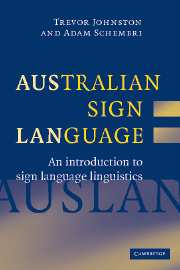Book contents
- Frontmatter
- Contents
- Acknowledgements
- Conventions for sign notation
- 1 Signed languages and linguistics
- 2 Auslan in social context
- 3 Auslan and other signed languages
- 4 Phonetics and phonology: the building blocks of signs
- 5 Morphology: sign formation and modification
- 6 Lexicon: the structure of Auslan vocabulary
- 7 Syntax: the structure of sentences in Auslan
- 8 Semantics and pragmatics: sign meaning and sentence meaning
- 9 Discourse: structure and use above the sentence
- 10 Issues in the study of signed languages
- References
- Index
1 - Signed languages and linguistics
Published online by Cambridge University Press: 02 December 2009
- Frontmatter
- Contents
- Acknowledgements
- Conventions for sign notation
- 1 Signed languages and linguistics
- 2 Auslan in social context
- 3 Auslan and other signed languages
- 4 Phonetics and phonology: the building blocks of signs
- 5 Morphology: sign formation and modification
- 6 Lexicon: the structure of Auslan vocabulary
- 7 Syntax: the structure of sentences in Auslan
- 8 Semantics and pragmatics: sign meaning and sentence meaning
- 9 Discourse: structure and use above the sentence
- 10 Issues in the study of signed languages
- References
- Index
Summary
In this chapter, we discuss the discovery of signed languages as real languages and describe their place within modern linguistics. We begin by defining language and linguistics. First, we explore some of the properties language shares with other systems of communications, as well as features that may make language unique. Second, we introduce the field of linguistics—the scientific study of language—and its major areas of investigation. We then discuss signed language linguistics and its history, examine common myths and misconceptions about signed languages, and describe the relationship between signed languages and other forms of gestural communication.
What is language?
One of the aims of the field of linguistics is to understand exactly what language is, so providing a definition is difficult because the study of language is very much work in progress. In addition, many contemporary textbooks in linguistics discuss definitions of language that were proposed before signed languages were recognised as real languages. Thus, in order to provide a working definition of language, we will draw on a useful summary first provided by the researchers Charlotte Baker and Dennis Cokely (1980): a language is a complex system of communication with a vocabulary of conventional symbols and grammatical rules that are shared by members of a community and passed on from one generation to the next, that changes across time, and that is used to exchange an open-ended range of ideas, emotions and intentions.
This working definition draws on a number of key features that were proposed by Charles Hockett (1960) to be central aspects of language structure and function: the use of arbitrary symbols, grammaticality, discreteness, duality of patterning, cultural transmission, inter-changeability, reflexiveness, displacement and creativity.
- Type
- Chapter
- Information
- Australian Sign Language (Auslan)An introduction to sign language linguistics, pp. 1 - 26Publisher: Cambridge University PressPrint publication year: 2007



